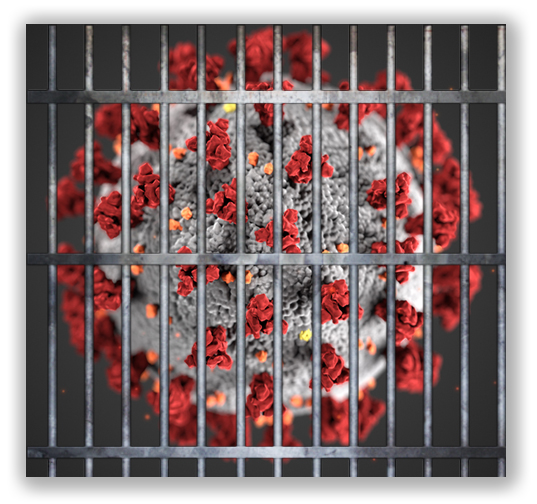We post news and comment on federal criminal justice issues, focused primarily on trial and post-conviction matters, legislative initiatives, and sentencing issues.

CAN YOU HEAR ME NOW?
 A week ago, America had 136,000 COVID-19 cases with 2,052 deaths. As of 6 am EDT today, the nation had over 336,830 cases and 9,618 deaths. A week ago, the Bureau of Prisons reported 14 inmates and 13 staff down with the virus. As of 3 pm yesterday, the BOP had 138 inmates and 59 staff down with the virus at Atlanta, Brooklyn, Bennettsville, the Butner complex; Canaan; Carswell; Chicago; Danbury; Elkton; Forrest City; Ft. Dix; Leavenworth, Lompoc, Milan, New York, Oakdale, Otisville, Ray Brook, Talladega, Tucson, the Yazoo City complex, and several RRC offices and facilities.
A week ago, America had 136,000 COVID-19 cases with 2,052 deaths. As of 6 am EDT today, the nation had over 336,830 cases and 9,618 deaths. A week ago, the Bureau of Prisons reported 14 inmates and 13 staff down with the virus. As of 3 pm yesterday, the BOP had 138 inmates and 59 staff down with the virus at Atlanta, Brooklyn, Bennettsville, the Butner complex; Canaan; Carswell; Chicago; Danbury; Elkton; Forrest City; Ft. Dix; Leavenworth, Lompoc, Milan, New York, Oakdale, Otisville, Ray Brook, Talladega, Tucson, the Yazoo City complex, and several RRC offices and facilities.
Also a week ago, Attorney General William Barr urged the BOP to use its statutory authority to release low-risk inmates at heightened risk because of COVID-19. Since then, response has been spotty: at some places, staff has quickly and efficiently carried out the directive, at others, staff is reviewing only people over 65, and at one institution I heard about, the warden told inmates that despite the Barr memo “no one was going anywhere.”
Meanwhile, inmates have begun dying, five at Oakdale and three at Elkton. Danbury has 21 female inmates down with COVID-19, and Lompoc has 17 sick male inmates.
Last Friday, maybe out of desperation as the virus spread, maybe out of irritation with the BOP’s snail pace, Barr issued another memo to BOP Director Michael Carvajal, “directing you to immediately review all inmates who have COVID-19 risk factors, as established by the CDC, starting with the inmates incarcerated at FCI Oakdale, FCI Danbury, FCI Elkton, and similarly situated facilities where you determine that COVID-19 is materially affecting operations. You should begin implementing this directive immediately at the facilities I have specifically identified and any other facilities facing similarly serious problems.”
The memo ordered that the BOP’s review should “include all at-risk inmates—not only those who were previously eligible for transfer.” The eligible inmates should immediately be processed for transfer to home confinement and put in 14-day quarantine.
 Noting that the US Probation Office is unable to monitor large numbers of inmates in the community, Barr “authorize[d] BOP to transfer inmates to home confinement even if electronic monitoring is not available, so long as BOP determines in every such instance that doing so is appropriate and consistent with our obligation to protect public safety.”
Noting that the US Probation Office is unable to monitor large numbers of inmates in the community, Barr “authorize[d] BOP to transfer inmates to home confinement even if electronic monitoring is not available, so long as BOP determines in every such instance that doing so is appropriate and consistent with our obligation to protect public safety.”
It almost seems that Barr is asking the BOP, “Can you hear me now?”
The directive that the BOP use its CARES Act § 12003(b)(2) authority will clearly cause some disparities in treatment. By focusing on institutions where the COVID-19 is present, nearly 100 facilities may see few if any releases for now. Furthermore, the release may skew strongly in favor of minimum-security inmates.
Kyle O’Dowd, associate executive director of policy for the National Association of Criminal Defense Lawyers, expressed his concern to Law360 a week ago that the release directive “won’t be implemented as robustly as it needs to be. There is a history of BOP being pretty conservative in their application of authorities they already have.” He was especially concerned that PATTERN scores would be used as a basis for home confinement decisions. “”If it is relied on too heavily, I think we will see just a trickle of releases rather than the more expansive application of that authority that we need under the current circumstances,” he said.
 The BOP, of course, is in the middle of a 14-day lockdown, intended to arrest the spread of COVID-19. The action, started April 2, is subject to extension. One criminal justice advocate expressed disappointment in the lockdown, saying it is likely to aggravate problems related to the virus, not ameliorate them.
The BOP, of course, is in the middle of a 14-day lockdown, intended to arrest the spread of COVID-19. The action, started April 2, is subject to extension. One criminal justice advocate expressed disappointment in the lockdown, saying it is likely to aggravate problems related to the virus, not ameliorate them.
“How incredibly short-sighted, contrary to the advice of any experts, and inhumane,” Chris Geidner of the Justice Collaborative wrote on Twitter. The Week complained that the lockdown may be “too little, too late. Inmates will remain packed in close quarters, eating and bathing communally, disproportionately likely to have comorbidities which exacerbate the risk posed by COVID-19, and too often stuck with insufficient medical care or hygiene supplies.”
At the same time, there is ample concern that the BOP is not an especially trustworthy arbiter of home confinement decisions, based on its COVID-19 record to date. A week ago, the Washington Post noted that the BOP “updates confirmed coronavirus cases most afternoons on its website, but there has been a lag between cases reported by the officers’ union and prison officials.” It observed that BOP staff at Oakdale had “asked prison officials — weeks before the first coronavirus case — to shut down a prison labor program within the facility, where more than 100 prisoners make inmate clothing.” According to correctional officers union official Corey Trammel, the UNICOR line was not shut down until after the first inmate tested positive.
And although the BOP has admitted to COVID-19 outbreaks at BOP-contracted halfway houses in five locations, it told a reporter for The Appeal that it had “no factual evidence to support… allegations” that the facilities were at high risk for coronavirus outbreak.
 Most damning, however, might be last Friday’s Marshall Project report that Dr. Sylvie Cohen, the BOP’s chief of occupational and employee health, ordered several Oakdale staff members back to work the day after they took inmate Patrick Jones (who later became the BOP’s first COVID-19 death) to the hospital. The correctional officers were issued no protective equipment other than latex gloves. Dr. Cohen, according to the story, directed that “officers should work unless they showed symptoms. This contradicts the recommendations the Centers for Disease Control was giving for first responders and other frontline workers and the specialized guidance it issued a day later for prisons and jails, calling for people who have had close contact with a confirmed case of COVID-19 to isolate themselves at home for 14 days.”
Most damning, however, might be last Friday’s Marshall Project report that Dr. Sylvie Cohen, the BOP’s chief of occupational and employee health, ordered several Oakdale staff members back to work the day after they took inmate Patrick Jones (who later became the BOP’s first COVID-19 death) to the hospital. The correctional officers were issued no protective equipment other than latex gloves. Dr. Cohen, according to the story, directed that “officers should work unless they showed symptoms. This contradicts the recommendations the Centers for Disease Control was giving for first responders and other frontline workers and the specialized guidance it issued a day later for prisons and jails, calling for people who have had close contact with a confirmed case of COVID-19 to isolate themselves at home for 14 days.”
Like the Post, The Marshall Project suggested that the BOP’s official count of inmates and staff with COVID-19 was low. “Union officials say the toll is much higher,” the story noted. “On Wednesday,” the story reported, “prison brass met with a few dozen people held at the camp to discuss the virus, according to two of their family members. ‘Look, we probably all have it,’ officials told the prisoners, according to the wife of one man who attended. ‘It’s too late for us.’ They apologized, and said they were scared too, said the woman…”
Dept. of Justice, Increasing Use of Home Confinement at Institutions Most Affected by COVID-19 (Apr. 3)
Law 360, Federal Prisons Can Send More Inmates Home. Will They? (Mar. 26)
Washington Post, An explosion of coronavirus cases cripples a federal prison in Louisiana (Mar. 29)
Politico, Federal prisons start 14-day lockdown to fight virus (Apr 1)
The Week, When a prisoner dies of coronavirus, is the virus really to blame? (Apr. 2)
The Appeal, Halfway House Residents Describe ‘A Scary Situation’ As Coronavirus Sweeps the U.S. (Mar. 31)
The Marshall Project, Federal Prisons Agency “Put Staff in Harm’s Way” of Coronavirus (Apr. 3)
– Thomas L. Root


 Section 602 of the Act amended 18 USC 3624(c)(2) – which authorizes home confinement for prisoners at the end of their sentences for a period not to exceed the lesser of 10% of their sentences or 6 months – to add that “the Bureau of Prisons shall, to the extent practicable, place prisoners with lower risk levels and lower needs on home confinement for the maximum amount of time permitted under this paragraph.”
Section 602 of the Act amended 18 USC 3624(c)(2) – which authorizes home confinement for prisoners at the end of their sentences for a period not to exceed the lesser of 10% of their sentences or 6 months – to add that “the Bureau of Prisons shall, to the extent practicable, place prisoners with lower risk levels and lower needs on home confinement for the maximum amount of time permitted under this paragraph.” Even after passage of the Act, the BOP used the delay in adoption of the PATTERN risk and needs assessment protocol as a basis for not maximizing home confinement. After all, the argument went, no one knows if someone falls into the “lower risk levels and lower needs” category without a PATTERN analysis.
Even after passage of the Act, the BOP used the delay in adoption of the PATTERN risk and needs assessment protocol as a basis for not maximizing home confinement. After all, the argument went, no one knows if someone falls into the “lower risk levels and lower needs” category without a PATTERN analysis.











